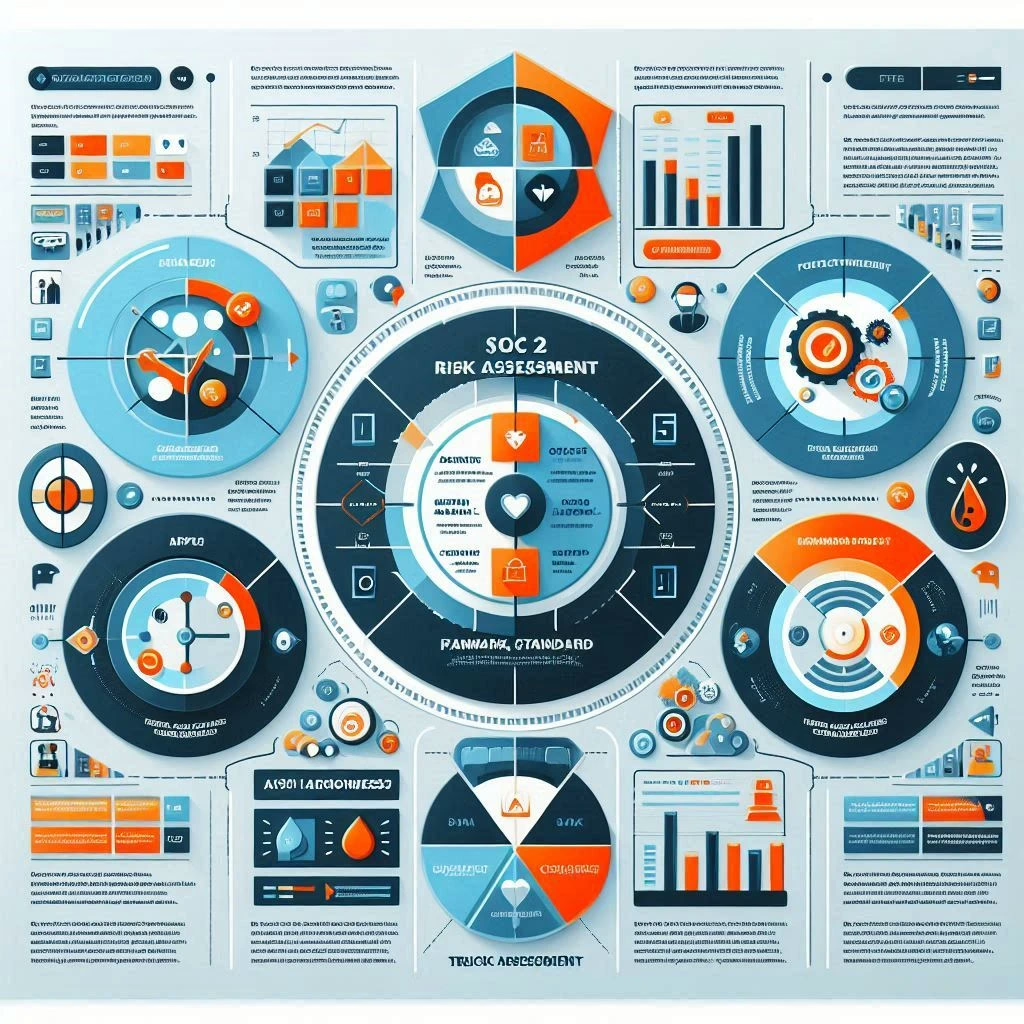Introduction to ERM
Enterprise Risk Management (ERM) is a comprehensive and structured approach that organizations adopt to identify, assess, manage, and monitor risks that could potentially impact their objectives. It encompasses a wide range of components, including risk identification, risk assessment, risk response, and risk monitoring, all of which are essential for effective governance and decision-making within an organization.
Definition of ERM and Its Components
ERM is defined as a methodology that strategically addresses risk management from the perspective of the entire organization, rather than in isolated silos. The key components of ERM include:
- Risk Identification: Recognizing potential risks that could affect the organization’s ability to achieve its objectives.
- Risk Assessment: Evaluating the likelihood and impact of identified risks to prioritize them effectively.
- Risk Response: Developing strategies to mitigate, transfer, accept, or avoid risks based on their assessment.
- Risk Monitoring: Continuously tracking risks and the effectiveness of risk management strategies to ensure they remain relevant and effective over time [8][14].
Importance of ERM in Organizational Governance
The significance of ERM in organizational governance cannot be overstated. It provides a framework that enhances decision-making by offering a holistic view of both risks and opportunities associated with achieving the organization’s mission. By integrating ERM into governance structures, organizations can:
- Improve accountability and transparency in risk management processes.
- Foster a culture of risk awareness throughout the organization.
- Align risk management efforts with strategic objectives, ensuring that risks are managed in a way that supports the overall goals of the organization [14][10].
Relationship Between ERM and Internal Audit
The relationship between ERM and internal audit is crucial for ensuring that risk management efforts are effectively aligned with organizational objectives. Internal auditors play a vital role in this integration by:
- Providing assurance on the effectiveness of risk management practices, ensuring that established processes function as intended and contribute to achieving organizational goals [10].
- Assisting in the implementation of ERM by evaluating governance structures, risk management processes, and internal controls, thereby identifying areas for improvement [3][7].
- Offering insights and recommendations that help enhance the overall risk management framework, ensuring that it remains robust and responsive to changing organizational needs [9][11].
Understanding the ERM Framework
The Enterprise Risk Management (ERM) framework serves as a vital tool for enhancing the effectiveness and efficiency of audit methodologies. By integrating ERM principles, internal audit teams can better align their activities with the organization’s strategic objectives and risk management practices. Below are the key elements of the ERM framework that are particularly relevant to internal audit practices.
Components of the ERM Framework
- Risk Assessment:
- This is the foundational step in the ERM process, where organizations identify and evaluate risks that could impact their objectives. Internal audit teams should engage in comprehensive risk assessments to understand the potential threats and opportunities facing the organization. This involves analyzing both internal and external risks and prioritizing them based on their potential impact and likelihood of occurrence [4].
- Risk Response:
- Once risks are assessed, the next step is to determine how to respond to them. This can include risk avoidance, reduction, sharing, or acceptance. Internal auditors play a crucial role in evaluating the effectiveness of these responses and ensuring that they align with the organization’s risk appetite and tolerance levels. This alignment is essential for making informed decisions that support the organization’s overall strategy [5].
- Monitoring:
- Continuous monitoring of risk management practices is essential to ensure that the ERM framework remains effective over time. Internal audit teams should regularly review and assess the risk management processes to ensure they are functioning as intended and contributing to the achievement of organizational objectives. This ongoing oversight helps identify any emerging risks and allows for timely adjustments to risk management strategies [6].
Role of Risk Appetite and Tolerance in Decision-Making
Understanding the concepts of risk appetite and tolerance is critical for internal audit teams.
- Risk Appetite refers to the amount and type of risk that an organization is willing to pursue or retain in pursuit of its objectives. It serves as a guiding principle for decision-making and helps ensure that the organization does not take on excessive risk that could jeopardize its strategic goals.
- Risk Tolerance, on the other hand, defines the acceptable level of variation in performance related to specific objectives. It provides a more granular view of how much risk is acceptable in different areas of the organization. Internal auditors must consider both risk appetite and tolerance when evaluating the effectiveness of risk management practices and ensuring that the organization remains within its defined risk boundaries [12].
Supporting Strategic Objectives
The ERM framework is designed to support and enhance the achievement of strategic objectives. By integrating risk management into the decision-making process, organizations can ensure that risks are identified and managed proactively, rather than reactively.
- This proactive approach allows internal audit teams to provide valuable insights into how risks may impact strategic initiatives and to recommend adjustments to mitigate those risks effectively. By aligning audit activities with the organization’s strategic goals, internal auditors can contribute to improved business performance and resilience [1][3].
Assessing Current Audit Methodologies
Integrating Enterprise Risk Management (ERM) principles into internal audit practices is essential for enhancing the effectiveness and relevance of audit methodologies. This section aims to guide internal audit teams and audit managers in evaluating their existing practices to identify gaps in ERM integration. Here are some best practices to consider:
- Conduct a SWOT Analysis of Current Audit Practices:
- A SWOT (Strengths, Weaknesses, Opportunities, Threats) analysis provides a structured approach to assess the current state of audit methodologies. By identifying strengths, teams can leverage successful practices, while weaknesses highlight areas needing improvement. Opportunities may reveal potential enhancements through ERM integration, and threats can indicate external risks that could impact audit effectiveness. This comprehensive evaluation helps in aligning audit practices with ERM principles, ensuring a proactive approach to risk management [1].
- Identify Risks That Are Not Being Adequately Addressed:
- A critical aspect of integrating ERM into internal audit is recognizing risks that may have been overlooked in current methodologies. This involves reviewing existing risk assessments and audit scopes to ensure that all significant risks, including emerging and strategic risks, are considered. By identifying these gaps, audit teams can adjust their focus and resources to address areas that pose the greatest threat to organizational objectives [1][11].
- Gather Feedback from Stakeholders Regarding Audit Effectiveness:
- Engaging with stakeholders, including management, the board, and operational teams, is vital for understanding the perceived effectiveness of current audit practices. Feedback can provide insights into areas where audits may not be meeting expectations or where risks are not being adequately addressed. This collaborative approach fosters a culture of continuous improvement and ensures that audit methodologies evolve in line with organizational needs and ERM principles [1][12].
Integrating ERM Principles into Audit Processes
Incorporating Enterprise Risk Management (ERM) principles into internal audit methodologies is essential for enhancing the effectiveness and relevance of audit functions. Here are actionable steps to embed ERM principles into your internal audit processes:
- Develop a Risk-Based Audit Plan Aligned with ERM Objectives:
- Start by understanding the organization’s overall risk appetite and strategic objectives. This alignment ensures that the audit plan addresses the most significant risks that could impact the achievement of these objectives. A risk-based approach allows internal audit teams to prioritize their resources effectively, focusing on areas that pose the highest risk to the organization’s success [1][12].
- Incorporate Risk Identification and Assessment into Audit Procedures:
- Integrate risk identification and assessment into the audit process by utilizing tools and techniques that facilitate the identification of potential risks during audit planning. This could involve conducting risk assessments as part of the audit scoping process, ensuring that auditors are aware of the risks associated with the areas being audited. By embedding risk assessment into audit procedures, internal auditors can provide more relevant insights and recommendations that align with the organization’s risk management strategies [1][11].
- Create a Feedback Loop Between ERM and Audit Findings:
- Establish a systematic process for sharing audit findings with the ERM team. This feedback loop is crucial for ensuring that the insights gained from audits inform the organization’s risk management practices. Regular communication between internal audit and ERM teams can help identify emerging risks and enhance the overall risk management framework. This collaboration not only strengthens the organization’s risk culture but also ensures that audit findings are actionable and contribute to continuous improvement in risk management practices [1][4][12].
Tools and Technologies for ERM Integration
Integrating Enterprise Risk Management (ERM) principles into internal audit methodologies is essential for enhancing the effectiveness and efficiency of audit processes. The following tools and technologies can facilitate this integration, providing internal audit teams and audit managers with practical solutions to improve risk assessment and management.
Software Options for Risk Assessment and Management
- Risk Management Software: Various software solutions are available that specialize in risk assessment and management. These tools help organizations identify, analyze, and prioritize risks, ensuring that internal audits are aligned with the organization’s risk profile. Popular options include:
- LogicManager: Offers a comprehensive risk management platform that integrates with existing audit processes.
- RiskWatch: Provides tools for risk assessment, compliance management, and incident reporting, allowing auditors to streamline their workflows.
- MetricStream: A robust solution that combines risk management with compliance and audit functionalities, enabling a holistic view of organizational risks.
- ERM Frameworks: Utilizing established frameworks like the COSO ERM Framework can guide the selection of appropriate software tools. These frameworks provide structured approaches to risk management, ensuring that the chosen software aligns with organizational objectives and compliance requirements [11].
Data Analytics Techniques for Enhancing Audit Processes
- Predictive Analytics: Leveraging predictive analytics can significantly enhance internal audit processes by identifying potential risks before they materialize. This technique uses historical data to forecast future risks, allowing auditors to focus on high-risk areas.
- Continuous Monitoring: Implementing data analytics for continuous monitoring of transactions and controls can help auditors detect anomalies and trends in real-time. This proactive approach enables timely interventions and strengthens the overall risk management framework [5].
- Visualization Tools: Data visualization techniques can simplify complex data sets, making it easier for audit teams to identify patterns and insights. Tools like Tableau or Power BI can be integrated into audit processes to present data in an accessible format, facilitating better decision-making.
Role of Dashboards and Reporting Tools in Monitoring Risks
- Dashboards: Interactive dashboards provide a centralized view of key risk indicators (KRIs) and audit findings. These tools allow internal audit teams to monitor risks effectively and communicate findings to stakeholders in a visually engaging manner. Dashboards can be customized to reflect the specific risk appetite and objectives of the organization [6].
- Reporting Tools: Effective reporting tools are crucial for documenting audit results and risk assessments. Solutions like Microsoft Power BI or Qlik can automate reporting processes, ensuring that stakeholders receive timely and accurate information regarding risk management efforts. These tools can also facilitate compliance with regulatory requirements by providing clear and concise reports [12].
- Collaboration Platforms: Integrating collaboration tools such as Microsoft Teams or Slack can enhance communication among audit teams, enabling them to share insights and updates on risk management initiatives. This collaborative approach fosters a culture of transparency and accountability within the organization.
By leveraging these tools and technologies, internal audit teams can effectively integrate ERM principles into their methodologies, enhancing their ability to identify, assess, and manage risks. This integration not only improves audit processes but also contributes to the overall resilience and success of the organization.
Training and Development for Audit Teams
Integrating Enterprise Risk Management (ERM) principles into internal audit methodologies is essential for enhancing the effectiveness of audit functions. Continuous learning and skill development are critical for audit teams to stay updated with the evolving landscape of risk management. Here are some best practices for training and development in this area:
- Identify Training Resources and Programs for ERM Principles: Audit teams should actively seek out training programs that focus on ERM principles. This includes workshops, online courses, and seminars that cover the fundamentals of ERM, risk assessment techniques, and the application of ERM frameworks. Utilizing resources from professional organizations and industry leaders can provide valuable insights and practical knowledge that can be directly applied to audit practices. Regular training sessions can help ensure that team members are well-versed in the latest ERM methodologies and tools, which is crucial for effective risk management [1].
- Encourage Cross-Departmental Collaboration for Knowledge Sharing: Fostering collaboration between internal audit teams and other departments can significantly enhance the understanding and implementation of ERM practices. By creating opportunities for knowledge sharing, such as joint training sessions or interdepartmental workshops, audit teams can gain insights into the risk perspectives of different functions within the organization. This collaborative approach not only enriches the audit process but also promotes a culture of risk awareness across the organization, leading to more comprehensive risk assessments and management strategies [2].
- Discuss the Importance of Certifications Related to ERM and Internal Audit: Obtaining relevant certifications can greatly enhance the credibility and expertise of audit professionals in the realm of ERM. Certifications such as the Certified Internal Auditor (CIA) or the Certification in Risk Management Assurance (CRMA) provide auditors with a solid foundation in risk management principles and practices. These credentials not only validate the skills of audit team members but also demonstrate a commitment to professional development and adherence to industry standards. Encouraging team members to pursue these certifications can lead to improved audit quality and a deeper understanding of ERM frameworks [3].
Monitoring and Continuous Improvement
Integrating Enterprise Risk Management (ERM) principles into internal audit methodologies is essential for enhancing the effectiveness of risk management practices within an organization. To ensure that this integration is not only effective but also continuously improving, internal audit teams should focus on the following key processes:
- Establish Key Performance Indicators (KPIs):
- Developing specific KPIs is crucial for measuring the effectiveness of ERM integration within the internal audit function. These indicators should align with the organization’s strategic objectives and risk appetite, providing a clear framework for assessing performance. Regularly reviewing these KPIs will help audit teams identify areas of strength and opportunities for improvement in their ERM practices [1][10].
- Conduct Regular Audits of the ERM Integration Process:
- Internal auditors should perform periodic assessments of the ERM integration process to ensure that it is functioning as intended. This involves evaluating the established risk management processes and their alignment with organizational goals. Regular audits can help identify gaps in the ERM framework and ensure that the internal audit function is effectively contributing to the organization’s risk management objectives [1][9].
- Implement a Continuous Feedback Mechanism for Improvement:
- Establishing a continuous feedback loop is vital for the ongoing enhancement of ERM integration. This mechanism should involve collecting input from various stakeholders, including management and staff, to identify potential issues and areas for improvement. By fostering a culture of open communication and continuous learning, internal audit teams can adapt their methodologies to better align with evolving risks and organizational needs [15][10].
By focusing on these key processes, internal audit teams can effectively monitor and improve the integration of ERM principles, ensuring that their audit methodologies remain relevant and effective in managing organizational risks. This proactive approach not only enhances the overall risk management framework but also supports the organization’s strategic objectives and promotes a sustainable risk culture.
Conclusion
Incorporating Enterprise Risk Management (ERM) principles into internal audit practices is essential for enhancing the effectiveness and strategic value of audit functions. ERM provides a structured approach to identifying, assessing, and managing risks across the organization, which aligns with the internal audit’s role in ensuring that risk management processes are functioning as intended and supporting the organization’s objectives [1][2].
Key Takeaways
- Importance of ERM in Internal Audit: ERM is not just a compliance requirement; it is a vital framework that helps internal auditors evaluate the effectiveness of risk management practices. By integrating ERM into audit methodologies, teams can better understand the risk landscape and provide more insightful recommendations to management [1][2].
- Commitment to ERM Principles: For internal audit teams to successfully implement ERM, there must be a collective commitment to its principles. This involves fostering a culture of risk awareness and accountability within the audit function, ensuring that all team members understand their role in the ERM process [3][4].
Find out more about Shaun Stoltz https://www.shaunstoltz.com/about/
This post was written by an AI and reviewed/edited by a human.



